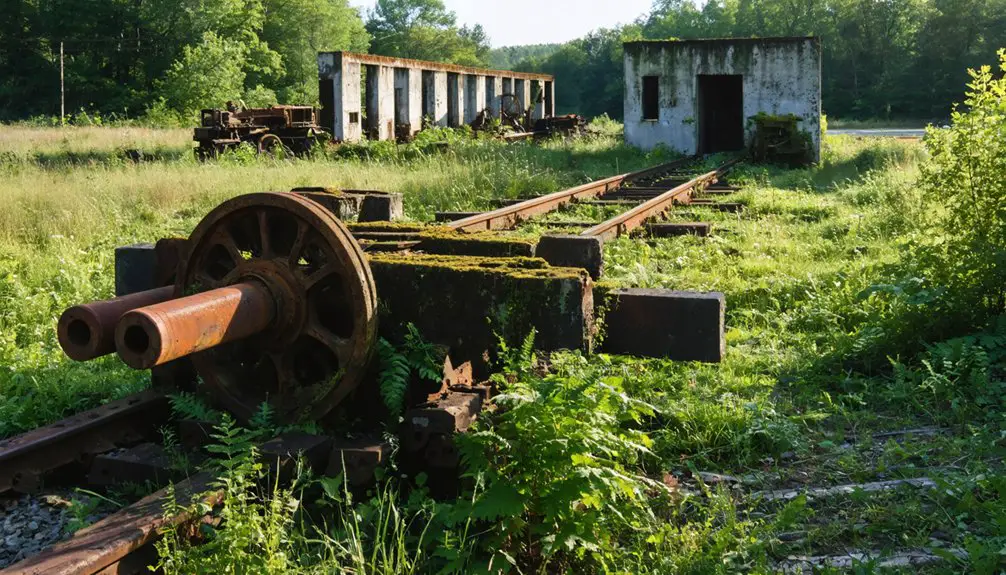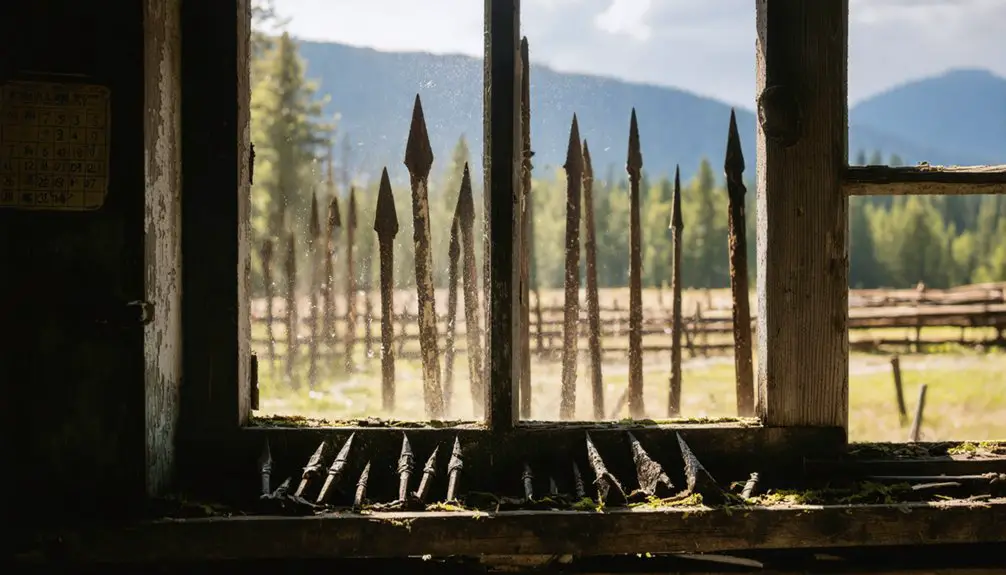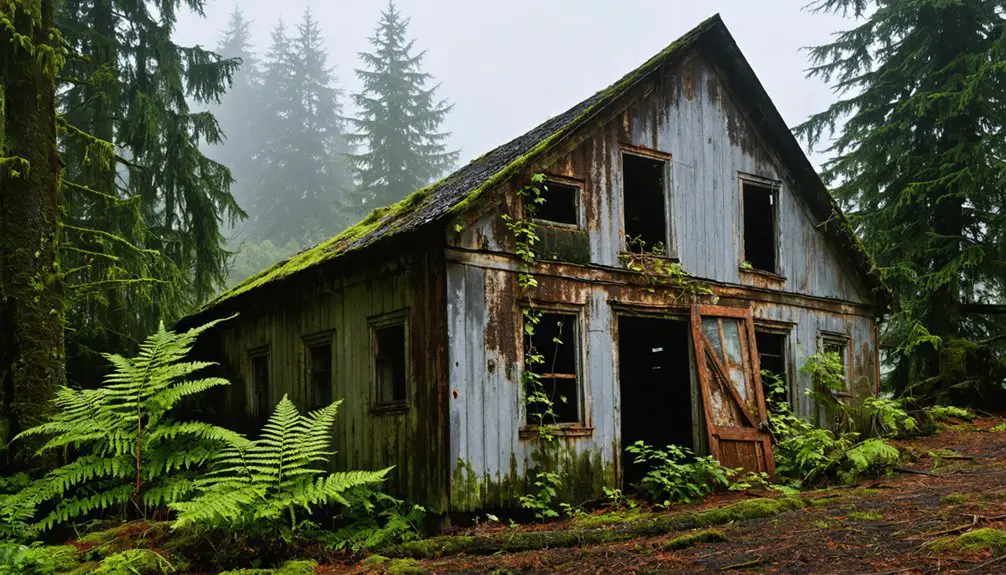You’ll find Walville’s ghostly remains tucked away in Washington’s forested landscape, where a bustling lumber town once thrived in the early 1900s. The town’s multicultural legacy lives on through its preserved Japanese cemetery, with nine marked graves marking the contributions of immigrant workers. After the central sawmill burned in 1934, Walville declined during the Great Depression. The overgrown railroad tracks and decaying buildings hold stories of labor struggles, cultural resilience, and industrial ambition.
Key Takeaways
- Walville was a thriving lumber town until its central sawmill burned down in 1934, marking the beginning of its decline.
- The town’s abandonment accelerated during the Great Depression when families left to seek opportunities elsewhere.
- Japanese immigrants formed a significant part of Walville’s community, leaving behind a cemetery that still exists today.
- Nature has reclaimed most of the former townsite, with only scattered remnants of buildings and industrial infrastructure remaining.
- The former railroad line that once connected Walville to Chehalis has been converted into a walking trail.
The Rise of a Lumber Empire
While Washington’s timber industry had humble beginnings with a single Hudson’s Bay Company sawmill in 1828, it quickly transformed into a lumber empire following the California Gold Rush of 1848.
You’ll find that by 1860, over two dozen steam sawmills dotted the Puget Sound region, many backed by California investors enthusiastic to capitalize on the growing demand.
The real lumber boom took off in the 1880s when steam-powered equipment and expanding railroads opened up previously inaccessible forests. The introduction of the Dolbeer donkey engine revolutionized logging operations by enabling the winching of logs over extended distances using steam power.
Companies like Walworth & Neville established company towns, including Walville in 1903, to support their massive operations. First commercial sawmills appeared near Colville and Spokane Falls in the late 1850s, marking the beginning of organized logging in Eastern Washington.
These settlements became crucial hubs where workers lived and worked, while lumber barons like Frederick Weyerhaeuser acquired vast tracts of forestland, forever changing Washington’s economic landscape.
Workers Unite: The IWW Legacy
You’ll spot the IWW’s iconic black cat symbol throughout Walville’s labor history, where this “sabo-tabby” represented workers’ power to sabotage unfair operations through direct action.
The fierce feline became a feared sight for lumber bosses during the transformative 1917 timber strike, which brought regional lumber operations to a standstill as workers demanded better conditions.
Through strategic organizing and bold tactics, the IWW’s presence in Walville marked a vital turning point when timber workers began claiming their collective voice against industrial exploitation.
The Industrial Worker newspaper helped coordinate actions across the Pacific Northwest’s timber camps, spreading the message of worker solidarity.
The nationwide FBI raids targeting IWW halls in September 1917 sought to crush the growing labor movement and its influential organizing efforts.
Black Cat Symbol Origins
The black cat symbol, known as the “sabocat” or “wild cat,” emerged as a powerful emblem of worker resistance through the Industrial Workers of the World (IWW) in the early 20th century.
Labor activist Ralph Chaplin popularized this black cat symbolism to represent the threat of workplace sabotage and wildcat strikes against uncooperative employers.
Drawing from northern European folklore where black cats signified misfortune, the IWW leveraged this imagery to warn bosses about potential labor unrest.
The symbol became a cornerstone of anarcho-syndicalist movements worldwide.
The IWW’s influence in Aberdeen led to massive strikes in 1912 that shut down operations across Western Washington.
You’ll find the symbol’s influence extended beyond the IWW, inspiring organizations like the Black Panthers and various anarchist collectives.
In the Pacific Northwest, particularly around Aberdeen and Grays Harbor’s lumber industry, the black cat became deeply connected to worker identity and resistance, even appearing as the logo for the Aberdeen Black Cats baseball team.
Labor Movement’s Turning Point
Much like the black cat symbolized worker resistance, the Industrial Workers of the World (IWW) emerged as a revolutionary force that forever changed American labor history. Founded in Chicago in 1905, the IWW pioneered a radical vision of labor solidarity by uniting workers across racial, gender, and skill divisions.
Led by influential figures like Eugene V. Debs, the organization challenged traditional union structures and advocated for revolutionary change. The IWW’s approach became increasingly radical, leading Debs to withdraw his support from the organization. You’ll find their legacy in groundbreaking tactics like sit-down strikes and direct action that challenged the very foundations of industrial capitalism.
Through grassroots organizing, the IWW led landmark actions like the 1912 Lawrence “Bread and Roses” strike, mobilizing 20,000 workers despite fierce opposition.
While government repression during WWI and the Red Scare eventually weakened the movement, the IWW’s principles of inclusive unionism and militant direct action laid the groundwork for future labor struggles throughout the Pacific Northwest and beyond.
Japanese Immigration and Cultural Heritage
During the late 1890s, Japanese immigrants known as Issei began settling in Washington state, particularly around Seattle and the Yakima Valley, where they established thriving communities despite facing significant discrimination.
You’ll find their cultural traditions of harmony and respect shaped their resilient response to challenges like the 1920s alien land laws and housing restrictions. They adapted by finding creative ways to lease farmland and established businesses from restaurants to sawmills.
While the 1907 Gentlemen’s Agreement and 1924 Immigration Act severely limited new arrivals, these restrictions couldn’t break the spirit of Washington’s Japanese community. Many had originally fled Japan due to economic hardship following the Meiji Restoration.
They preserved their heritage through strong family bonds and community solidarity, even as they faced mounting pressure from anti-Japanese organizations and discriminatory legislation. By the 1930s, the Japanese farming community had established itself on the Eastside, with Japanese workers comprising 90% of the agricultural workforce.
Life in Early 20th Century Walville
You’d find the daily rhythms of Walville’s workers dominated by the lumber mill‘s demanding schedule, with shifts starting at dawn and continuing until dusk in both logging and processing operations.
The town’s immigrant laborers, including a notable Japanese community, lived in modest housing clusters that formed tight-knit cultural groups despite the challenging conditions.
While most workers spent their days handling heavy timber and operating mill equipment, they’d gather in small social groups during off-hours, often based on shared cultural backgrounds and work assignments.
Daily Worker Routines
Life in early 20th century Walville revolved around the rhythms of the logging industry, with workers rising at first light to begin their demanding routines.
You’d start your day preparing tools near the millpond while horses and cattle were readied for skidding operations. Worker schedules centered on timber cutting and hauling, with teams coordinating throughout the day to maximize efficiency. Daily rituals included quick, hearty breakfasts and maintaining essential equipment.
- You’d find solidarity among Japanese and white workers, who managed to forge strong bonds despite regional tensions.
- Your workday followed the sun’s arc, from dawn preparations to dusk equipment maintenance.
- You’d join fellow workers for communal meals and social gatherings, strengthening the town’s collective spirit.
The town’s pulse beat strongest during daylight hours, when the mill hummed and railroad cars moved timber to distant markets.
Immigrant Community Dynamics
While timber drew workers from across the globe to Walville, the town’s immigrant community formed a rich tapestry of Swiss, German, Greek, Polish, and Japanese cultures.
You’d find these diverse groups maintaining their heritage through ethnic festivals, religious gatherings, and social clubs, even as they adapted to American life.
Despite facing discrimination and harsh working conditions, immigrant communities showed remarkable resilience. They built essential services like postal delivery and stores, while establishing churches and schools that became cultural anchors.
Language barriers often led to ethnic enclaves, but these tight-knit groups supported each other through labor struggles and economic uncertainty.
Through the International Workers of the World (IWW), immigrants fought for better wages and safer conditions, leaving a lasting legacy of community strength in the Willapa Hills region.
The Decline and Abandonment

Although Walville had established itself as a thriving lumber town in the early 1900s, its fate was sealed when the central sawmill burned down in 1934.
The town’s economic vulnerability became apparent as jobs disappeared and infrastructure neglect took hold. Without its primary economic driver and the railroad line to Chehalis being abandoned, Walville’s population rapidly declined. The Great Depression had already weakened the town’s resilience, making recovery nearly impossible.
- The once-bustling streets where Japanese workers and union members lived harmoniously fell silent as families were forced to seek opportunities elsewhere.
- Railroad tracks that once carried lumber and life to the town became overgrown, erasing essential transportation links.
- Fire lookouts and town buildings crumbled into decay, leaving only memories of a once-vibrant community.
Remnants and Ruins Today
Today, sparse remnants of Walville’s once-thriving lumber community dot the forested landscape, with the Japanese cemetery standing as the most significant preserved feature.
The Japanese cemetery endures as a silent sentinel, marking where Walville’s bustling lumber town once stood amid the forest.
You’ll find nine marked graves within a fenced area, plus scattered unmarked burial sites across the hillside, highlighting the cemetery’s significance to the region’s cultural heritage.
Nature has reclaimed most of the townsite, leaving only fragments of its industrial past.
You can spot scattered bricks, broken porcelain, and traces of the old mill site amid the vegetation.
The former railroad line, now converted to a walking trail, offers a path through history.
While most structures have vanished, the Japanese cemetery remains a powerful symbol of Walville’s multicultural past and the lives of its immigrant workers.
Preserving a Multicultural Past

Despite widespread anti-Japanese sentiment across early 20th century America, Walville fostered an unusually harmonious multicultural community where Japanese immigrants worked alongside white loggers with minimal racial tension.
Today, cultural preservation efforts focus on protecting physical remnants that tell this remarkable story – from the century-old Japanese cemetery with its nine marked graves to scattered porcelain fragments that once graced immigrant households.
- The black cat logo of the IWW union, originally Walville’s logging symbol, represents the town’s legacy of worker solidarity across racial lines.
- You’ll find poignant traces of community identity in the distinct “Japanese town” area along the creek.
- The cemetery stands as a sacred reminder of those who helped build this unique haven of cultural cooperation.
Exploring Washington’s Lost Town
Tucked away in Pacific County’s forested hills, Walville stands as a haunting tribute to Washington’s logging heritage.
As you explore this ghost town‘s remnants, you’ll discover traces of its diverse past scattered across distinct neighborhoods: “Cow Town,” where cattle once helped power the logging operations, the mill area surrounding the historic Mill Pond, and the Japanese settlement near the creek.
While Walville’s architecture has largely vanished, your ghost town exploration will reveal fascinating fragments.
You’ll find brick remnants, porcelain shards, and the weathered bases of old fire lookouts dotting the landscape. The most poignant discovery is the Japanese cemetery, where nine marked graves and several unmarked ones tell stories of the town’s multicultural heritage.
The converted rails-to-trails path now guides you through this forgotten logging community’s history.
Frequently Asked Questions
Are There Any Known Paranormal Activities Reported in Walville’s Abandoned Buildings?
You won’t find documented ghost sightings or eerie experiences in Walville’s abandoned structures. Despite its atmospheric ruins and Japanese cemetery, there’s no verified evidence of paranormal activity in this former logging town.
What Happened to the Original Town Records and Documents?
You’ll find most original records were lost in the 1934 mill fire, with no formal historical preservation efforts in place. Missing archives likely scattered during the town’s abandonment or deteriorated over time.
How Many Japanese Graves Remain Identifiable in the Cemetery Today?
You’ll find 9 identifiable Japanese heritage graves marked with crosses inside the fenced cemetery area today, though preservation challenges and weathering make some markers difficult to read clearly.
Was Walville Connected to Any Other Ghost Towns by Railroad?
You’ll find the railroad history connected Walville to several ghost towns, including logging camps between Chehalis and Raymond. The rail line served as a crucial transport link in Washington’s timber country.
Did Any Original Walville Families Continue Living Nearby After Abandonment?
Like scattered embers after the mill’s fire, you won’t find many family descendants living close by – except for a few folks in “Cow Town” on Walville’s outskirts, not original families.
References
- https://www.youtube.com/watch?v=elkY77cmOuE
- https://www.youtube.com/playlist?list=PLj88QmjC1f05Lly617L81aE2KIG2C1kZg
- https://en.wikipedia.org/wiki/List_of_ghost_towns_in_Washington
- https://napost.com/2023/voices2_0414/
- https://pnwphotoblog.com/ghost-town-of-walville-washington/
- https://www.historylink.org/File/23208
- https://www.historylink.org/File/23257
- https://sites.uw.edu/cspn/evergreen-state/
- https://www.washington.edu/uwired/outreach/cspn/Website/Classroom Materials/Curriculum Packets/Evergreen State/Section II.html
- https://revisitwa.org/waypoint/walville/



